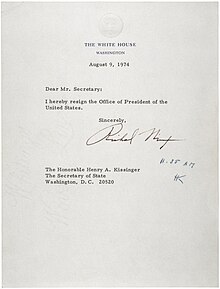United States Secretary of State
This article needs additional citations for verification. (April 2007) |
| United States Secretary of State | |
|---|---|
 Official seal | |
| United States Department of State | |
| Inaugural holder | Thomas Jefferson |
| Formation | April 6, 1789 |
| First holder | Thomas Jefferson[1] |
| Succession | Fourth |
| Website | www.state.gov |
The United States Secretary of State is the head of the United States Department of State, concerned with foreign affairs. The Secretary is a member of the Cabinet and the highest-ranking cabinet secretary both in line of succession and order of precedence. The current Secretary of State selected by President of the United States Barack Obama is Hillary Rodham Clinton. The office of the Secretary of State is one of the most high-profile positions in U.S. government. Three of the last four Secretaries of State have been women.
Functions

Most of the non-original domestic functions of the Department of State have been transferred to other agencies. Those that remain include storage and use of the Great Seal of the United States, performance of protocol functions for the White House, drafting of proclamations, and replies to inquiries. In accordance with the United States Constitution, the Secretary performs such duties as the President requires. These include negotiating with foreign representatives and instructing U.S. embassies or consulates abroad. The Secretary also serves as a principal adviser to the President in the determination of U.S. foreign policy and, in recent decades, has become responsible for overall direction, coordination, and supervision of interdepartmental activities of the U.S. Government overseas, excepting certain military activities.
As the highest-ranking member of the cabinet, the Secretary of State is fourth in line to succeed the Presidency, coming after the Vice President, the Speaker of the House of Representatives, and the President pro tempore of the Senate. (See United States presidential line of succession.)
Federal law (3 U.S.C. § 20) provides that a presidential resignation must be accomplished by written communication from the President to the office of the Secretary of State. This has occurred once, when President Richard Nixon resigned on August 9, 1974 via a letter to Secretary of State Henry Kissinger.
When there is a vacancy in the office of Secretary of State, it is exercised by another member of the cabinet, as was common in earlier history, or, in more recent times, by a subaltern official of the State Department until the President appoints and the United States Senate confirms a new Secretary.
List of Secretaries of State
External links
- The Department of State's organization page.
- The Department of State's list of current or former positions and titles.
- The Department of State's list of Secretaries of State
- ^ "Secretaries of State, 1789-2005". United States Department of State. Retrieved 2009-01-10.



